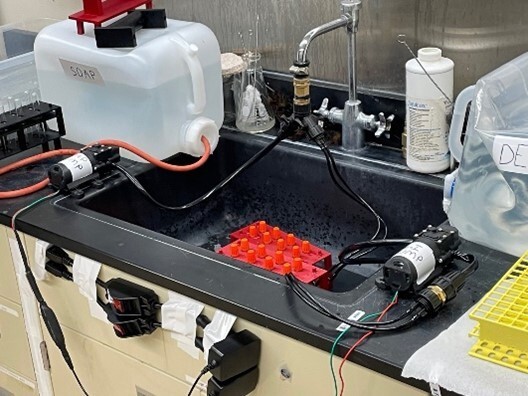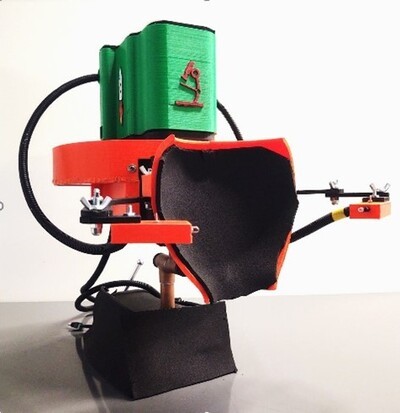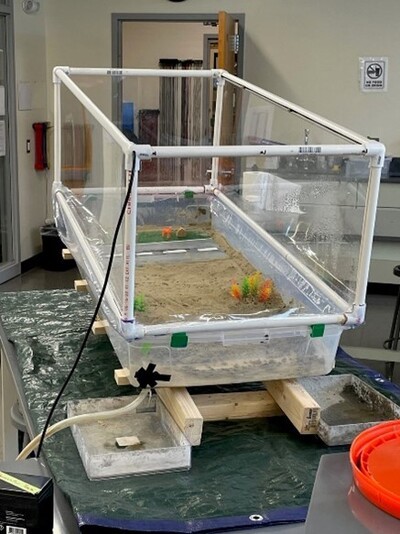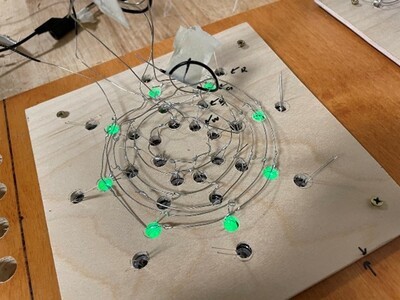RVCC Students Participate in “Authentic Engineering Experience”

During the 2022-2023 school year, several Raritan Valley Community College students participated in the “Authentic Engineering Experience” (AEE), in which they created real products for an actual client. The AEE projects were supported and coordinated by Main Engine Start (MES), a NJ Nonprofit Corporation led by company founder Peter Stupak, in conjunction with the RVCC Service Learning Program.
Twelve RVCC Engineering and Computer Science students participated in the following projects:
Water Quality Test-Tube Washer
RVCC students Bernard Babitsky, Melissa Armenta-Quiroz, and Mauricio Rios, along with project manager Liam Boyle, were tasked by Professor of Environmental Science Dr. Emilie Stander to create a novel, semi-automated/fully automated “Water Quality Sample Tube Washer.” Dr. Stander conducts environmental research at the College to assess the level of watershed contaminants that find their way into local streams and rivers. Accurate testing of chemical levels requires super-clean water-gathering equipment, and sample “tubes” are a critical link in the chain. To prevent waste, the tubes are currently cleaned by hand through a multi-step “wash-by-hand” process that removes sediment and trace chemical contaminants, allowing the tubes to be reused multiple times. However, the “wash-by-hand” process is long and time consuming. The AEE team developed an eight-tube washing device and process that passed the lab technician’s critical review.
Bacteria Image Analysis
RVCC student Matthew Wei, along with project manager Liam Boyle, were tasked by Professor of Environmental Science Emilie Stander to develop an automated image analysis that can count bacterial colonies resulting from water quality testing samples. The water taken from streams, rivers, and ponds is deposited on biological growth media to provide an environment for bacterial growth. To quantify the bacterial concentration in the water sample, the bacterial colonies historically have been counted manually – but this is a long and tedious process. Matthew Wei made progress in developing an automated image analysis and counting system. Difficulties in consistently identifying the bacterial colonies and distinguishing the red/blue bacteria type difference will result in the project being extended to fall 2023.
Watershed Demonstration Table
RVCC students Madeleyn Andrade Cajamarca and Oliver Tenny were tasked by artist Lauren Rosenthal McManus to design, develop, and fabricate a fully functional prototype of a “Watershed Table” that allows time-lapse video to be taken of watershed erosion phenomena resulting from climate change-induced increase rainfall rates. Features including permeable (e.g., sand and soil) and impermeable surfaces (e.g., parking lots), vegetation, trees, slope angle, and rain fall rates and quantity were included. The time-lapse video will be used to inform and educate decision makers and the public.
Art Illumination (Part 2) – Industrialization
RVCC students Aashitha Srinivas and Lavern Ronoh were tasked by Professor of Graphic Design Darren McManus to “industrialize” the fully functional prototype made by the previous teams (Part 1). Lavern Ronoh designed and made prototypes of the required circuit during the 2022 summer and fall semester. Aashitha Srinivas worked in spring 2023 to replicate the circuit, complete the design and assembly of the display unit, and assume full responsibility for the completion of six Art Illumination units that will be used in Professor McManus’ exhibition in spring 2024.
Power Assisted Rotating Head Support (Part 3)
RVCC students Ahmad Insanally, Mahmoud Mohamed, Marcelo Rios, and project manager Kyle Hammermueller “industrialized” the “Power Assisted Rotating Head Support” to make it ready to mount to a wheelchair and be tested in service. Some key “industrialization” points included: protecting and isolating the device’s mechanical gears, motor, and electronics in a protective case; reducing the motor noise; developing a battery-power level circuit; and improving the “ear control” switch sensitivity by using a new light-activated proximity switch.
###
June 6, 2023



